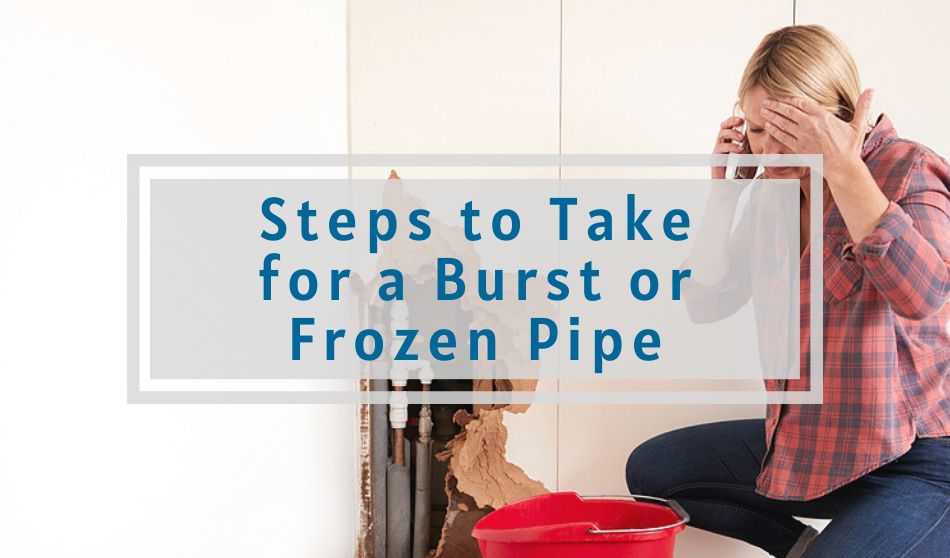
Proper maintenance in advance of winter storms can keep issues like frozen or burst pipes, and other cold-weather damage at bay. Winterization is key to ensure that your living space is truly ready for every obstacle the cold weather can bring.
Unfortunately, an early freeze can still catch you off-guard, so what do you do if your pipes freeze?
How to Deal with a Burst Pipe
Water damage from burst pipes (and similar issues) is the second-most filed insurance claim in the U.S. While the best way to deal with freezing pipes is to prevent them in the first place, thankfully, and not every pipe that freezes will burst, some pipes will burst from the pressure created from water expanding as it freezes. When this happens, a leak at a joint or crack on a length of pipe will unleash the full flow of water inside your home.
If a pipe bursts, you will need to act quickly to mitigate property damage and repair cost.
Steps to Take if a Pipe Bursts:
- Immediately locate your main water supply and shut it off to minimize flooding. This may involve simply flipping the shut-off valve in your home, or it may require you to call your municipal water company and request they send personnel to shut off the water supply to your home or building.
- Dry out the affected area by removing as much water as possible using mops, sponges, towels, and a shop vac or wet/dry vacuum.
- To prevent excess damage due to moisture build-up, run a dehumidifier in the space.
- Make arrangements with a licensed plumber to ensure the pipe is appropriately repaired.
Special Notes for Renters:
If you are renting, it is vital to promptly call your landlord or property manager’s emergency maintenance line for further instructions. Ensure that you immediately follow your property manager’s instructions for addressing the problem; addressing the issue incorrectly or with delay can lead to additional damage that you may be responsible to pay. If water has damaged items that you own, be sure to take note in case you need to make a renters insurance claim.
Assessing Frozen Pipes:
Since not every frozen pipe bursts, a geyser in your home isn’t the only sign indicating that a pipe has frozen. If after a big freeze, you find that your faucets do not flow (or only release a small trickle of water) or your toilets do not refill when flushed, you are likely dealing with a frozen pipe. Before attempting to thaw a frozen pipe, ensure that you have cut off the water supply to that section of plumbing or the house itself. Expanding and freezing water can act as a plug damming up any cracks it may have created. The last thing you want is to thaw your pipe and allow gallons of water to rush through your newly defrosted pipe.
How to Thaw Frozen Pipes:
Even if your water supply is shut off, you will deal with some spillage from the defrosted water when thawing your pipes. Be ready with a bucket and towels or a mop or with a wet/dry vac to mitigate any mess.
To thaw your pipes, use a space heater, an infrared or incandescent heat lamp, or hair dryer to warm the frozen pipe. You can also wrap your frozen pipe in heat tape to thaw a specific area according to manufacturers’ instructions. Do not use an open flame to thaw your pipes, items like propane torches may seem efficient, but poses a huge fire hazard and can damage the pipe. Heat tape can also be used to prevent pipes from freezing in critical areas; you can leave the heat tape on the pipe and plug it in only when needed.
Preventing Frozen Pipes:
Once you have gone through the pain and stress associated with a burst or frozen pipe, you will likely not want to go through that experience again. Winterizing the property is key to ensuring that your property and your sanity are maintained throughout the cold season.
There are a few things you can do to prevent frozen pipes for the future:
- Leave your faucet running at a trickle during the coldest parts of the day or night. Keeping the water flowing can keep your pipes from freezing.
- Open any cabinet doors to warm up the pipes under your sinks and inside cabinets.
- Wrap your pipe with electrical heat tape when your area is due for a freeze.
- Insulate your pipes with foam insulation. Keep in mind that Insulation merely slows the transfer of heat and will not prevent a pipe from freezing if the temperatures drop enough.
- Remove garden hoses attached to outdoor faucets and cover them with a foam protector.
- Heat unheated areas (such as an attached garage or basement) with a permanent heater, to keep the temperature above freezing.
- Note: Do not use a portable space heater for this purpose, since they should never be left running unattended.
Winter maintenance ahead of time can save you a lot of stress and can protect your hard-earned cash. If you had to learn your lesson the hard way, don’t get caught in a similar predicament during the next big freeze. Instead, prep your property appropriately to ensure that your pipes will be ready to handle the cold.






